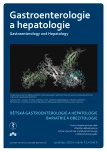Vitamin D – substitution after malabsorption operations
Authors:
Hlavatý P.; Šrámková P.
Authors‘ workplace:
OB klinika a. s., Centrum pro léčbu obezity a metabolických onemocnění, Praha
Published in:
Gastroent Hepatol 2019; 73(6): 488-491
Category:
doi:
https://doi.org/10.14735/amgh2019488
Overview
Vitamin D is a biologically active substance with a significant impact on human health. More than 100 years ago, fish oil, containing high concentrations of vitamin D, was administered to infants and young children as an effective means of preventing rickets. Later, vitamin D treatment was shown to prevent softening of bone, even in adults. In additon to its association with bone health, vitamin D has been shown to have neuromuscular, immunomodulatory, and cardiovascular activities, as well as antiproliferative and anti-angiogenic effects. Vitamin D deficiency is common, especially in the elderly, as well as being one of the most common deficiencies in patients after bariatric surgery. Therefore, it is necessary to monitor vitamin D levels in these patients pre-operatively and at regular postopertive intervals. Patients undergoing malabsorption surgery must take lifelong vitamin D supplements.
Submitted: 9. 10. 2019
Accepted: 9. 12. 2019
Conflict of Interest: The authors declare that the article/manuscript complies with ethical standards, patient anonymity has been respected, and they state that they have no financial, advisory or other commercial interests in relation to the subject matter.
Publication Ethics: This article/manuscript has not been published or is currently being submitted for another review. The authors agree to publish their name and e-mail in the published article/manuscript.
Dedication: The article/manuscript is not supported by a grant nor has it been created with the support of any company.
The Editorial Board declares that the manuscript met the ICMJE „uniform requirements“ for biomedical papers.
Keywords:
metabolic surgery – biliopancreatic diversion – vitamin D substitution
Sources
1. Hlúbik P, Opltová L. Vitaminy. Praha: Grada Publishing 2004.
2. Společnost pro výživu o. s. Referenční hodnoty pro příjem živin. Praha: Výživaservis s. r. o. 2011.
3. Stárka L. Pokroky v endokrinologii. Praha: Maxdorf 2007.
4. Lehmann B, Meurer B. Vitamin D metabolism. Dermatol Ther 2010; 23 (1): 2–12. doi: 10.1111/j.1529-8019.2009.01286.x.
5. Wacker M, Holick M. Vitamin D – effects on skeletal and extraskeletal health and the need for supplementation. Nutrients 2013; 5 (1): 111–148. doi: 10.3390/nu5010111.
6. Svačina Š, Hainerová I, Bretšnajdrová A et al. Poruchy metabolismu a výživy. Praha: Galen 2010.
7. Cashman KD, Kiely M. Recommended dietary intakes for vitamin D: where do they come from, what do they achieve and how can we meet them? J Hum Nutr Diet 2014; 27 (5): 434–442. doi: 10.1111/jhn.12226.
8. Konradsen S, Ag H, Lindberg F et al. Serum 1,25-dihydroxy vitamin D is inversely associated with body mass index. Eur J Nutr 2008; 47 (2): 87–91. doi: 10.1007/s00394-008-0700-4.
9. Parikh SJ, Edelman M, Uwaifo GI et al. The relationship between obesity and serum 1,25-dihydroxy vitamin D concentrations in healthy adults. J Clin Endocrinol Metab 2004; 89 (3): 1196–1199. doi: 10.1210/jc.2003-031398.
10. Watson RR. Nutrition in the prevention and treatment of abdominal obesity: diet, supplements and food in the management of visceral obesity. Effects on sleeve gastrectomy on calcium metabolism. USA: Academic Press 2014.
11. Ding CH, Gao D, Wilding J et al. Vitamin D signalling in adipose tissue. Br J Nutr 2012; 108 (11): 1915–1923. doi: 10.1017/S0007114512003285.
12. Ross A. Dietary reference intakes: calcium, vitamin D. Washington: National Academies Press 2011.
13. Cheng S, Massaro JM, Fox CS et al. Adiposity, cardiometabolic risk, and vitamin D status: the Framingham Heart Study. Diabetes 2010; 59 (1): 242–248. doi: 10.2337/db09-1011.
14. MacLaughlin JM, Holick MF. Aging decreases the capacity of human skin to produce vitamin D3. J Clin Invest 1985; 76 (4): 1536–1538. doi: 10.1172/JCI112134.
15. Kleerekoper M, Schleicher RL, Bouillon R et al. Clinical application for vitamin D assays: chat is known and chat is wished for. Clin Chem 2011; 57 (9): 1227–1232. doi: 10.1373/clinchem. 2010.154997.
16. Smelt HJ, Pouwels S, Celik A et al. Assessment of physical fitness after bariatric surgery and its association with protein intake and type of cholecalciferol supplementation. Medicina (Kaunas) 2019; 55 (6): 281. doi: 10.3390/medicina55060281.
17. Müllerová D. Výživa po bariatrických operacích. In: Fried M et al. Bariatrická a metabolická chirurgie. Nové postupy v léčbě obezity a metabolických poruch. Praha: Mladá fronta 2011.
18. Arias PM, Domeniconi EA, García M et al. Micronutrient deficiencies after roux-en-Y gastric bypass: long-term results. Obes Surg 2019. doi: 10.1007/s11695-019-04167-x.
19. Ybarra J, Sánchez-Hernández J, Gich I et al. Unchanged hypovitaminosis D and secondary hyperparathyroidism in morbid obesity after bariatric surgery. Obes Surg 2005; 15 (3): 330–335. doi: 10.1381/0960892053576758.
Labels
Paediatric gastroenterology Gastroenterology and hepatology SurgeryArticle was published in
Gastroenterology and Hepatology

2019 Issue 6
Most read in this issue
- Focal inflammatory liver lesions
- CDED diet in induction therapy of Crohn’s disease
- Vitamin D – substitution after malabsorption operations
- Allogeneic, mesenchymal stem cells (ALOFISEL) are effective in eradicating complex peri-anal fistulas in Crohn’s disease
